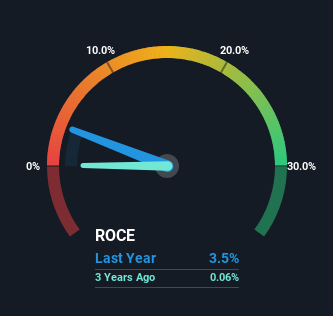- Slovenia
- /
- Metals and Mining
- /
- LJSE:UKIG
Capital Allocation Trends At UNIOR Kovaska industrija d.d (LJSE:UKIG) Aren't Ideal

Ignoring the stock price of a company, what are the underlying trends that tell us a business is past the growth phase? Businesses in decline often have two underlying trends, firstly, a declining return on capital employed (ROCE) and a declining base of capital employed. Basically the company is earning less on its investments and it is also reducing its total assets. In light of that, from a first glance at UNIOR Kovaska industrija d.d (LJSE:UKIG), we've spotted some signs that it could be struggling, so let's investigate.
Return On Capital Employed (ROCE): What Is It?
If you haven't worked with ROCE before, it measures the 'return' (pre-tax profit) a company generates from capital employed in its business. Analysts use this formula to calculate it for UNIOR Kovaska industrija d.d:
Return on Capital Employed = Earnings Before Interest and Tax (EBIT) ÷ (Total Assets - Current Liabilities)
0.035 = €11m ÷ (€388m - €79m) (Based on the trailing twelve months to September 2023).
So, UNIOR Kovaska industrija d.d has an ROCE of 3.5%. In absolute terms, that's a low return and it also under-performs the Metals and Mining industry average of 10%.
View our latest analysis for UNIOR Kovaska industrija d.d

While the past is not representative of the future, it can be helpful to know how a company has performed historically, which is why we have this chart above. If you want to delve into the historical earnings , check out these free graphs detailing revenue and cash flow performance of UNIOR Kovaska industrija d.d.
What Can We Tell From UNIOR Kovaska industrija d.d's ROCE Trend?
We are a bit worried about the trend of returns on capital at UNIOR Kovaska industrija d.d. Unfortunately the returns on capital have diminished from the 5.1% that they were earning five years ago. Meanwhile, capital employed in the business has stayed roughly the flat over the period. Since returns are falling and the business has the same amount of assets employed, this can suggest it's a mature business that hasn't had much growth in the last five years. So because these trends aren't typically conducive to creating a multi-bagger, we wouldn't hold our breath on UNIOR Kovaska industrija d.d becoming one if things continue as they have.
What We Can Learn From UNIOR Kovaska industrija d.d's ROCE
All in all, the lower returns from the same amount of capital employed aren't exactly signs of a compounding machine. It should come as no surprise then that the stock has fallen 33% over the last five years, so it looks like investors are recognizing these changes. Unless there is a shift to a more positive trajectory in these metrics, we would look elsewhere.
Since virtually every company faces some risks, it's worth knowing what they are, and we've spotted 4 warning signs for UNIOR Kovaska industrija d.d (of which 2 are significant!) that you should know about.
If you want to search for solid companies with great earnings, check out this free list of companies with good balance sheets and impressive returns on equity.
New: AI Stock Screener & Alerts
Our new AI Stock Screener scans the market every day to uncover opportunities.
• Dividend Powerhouses (3%+ Yield)
• Undervalued Small Caps with Insider Buying
• High growth Tech and AI Companies
Or build your own from over 50 metrics.
Have feedback on this article? Concerned about the content? Get in touch with us directly. Alternatively, email editorial-team (at) simplywallst.com.
This article by Simply Wall St is general in nature. We provide commentary based on historical data and analyst forecasts only using an unbiased methodology and our articles are not intended to be financial advice. It does not constitute a recommendation to buy or sell any stock, and does not take account of your objectives, or your financial situation. We aim to bring you long-term focused analysis driven by fundamental data. Note that our analysis may not factor in the latest price-sensitive company announcements or qualitative material. Simply Wall St has no position in any stocks mentioned.
About LJSE:UKIG
UNIOR Kovaska industrija d.d
Engages in the forging parts, hand tools, and special machines businesses in Slovenia, Europe, and internationally.
Good value with adequate balance sheet.
Market Insights
Community Narratives



